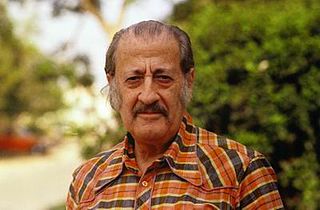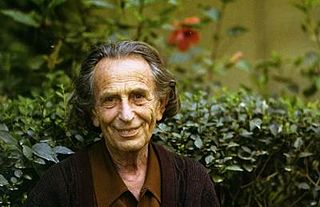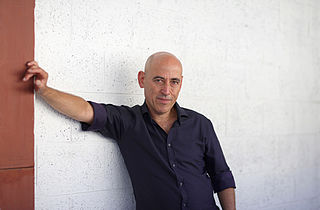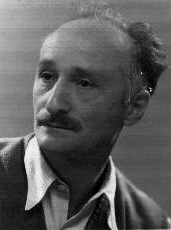Moshe Kupferman | |
|---|---|
 Photograph of Moshe Kupferman | |
| Born | 1926 |
| Died | 2003 |
| Nationality (legal) | Israeli, Jewish, Polish |
| Known for | Painting |
| Movement | Israeli art |
Moshe Kupferman (1926-2003) was an Israeli artist.
Moshe Kupferman | |
|---|---|
 Photograph of Moshe Kupferman | |
| Born | 1926 |
| Died | 2003 |
| Nationality (legal) | Israeli, Jewish, Polish |
| Known for | Painting |
| Movement | Israeli art |
Moshe Kupferman (1926-2003) was an Israeli artist.
Moshe Kupferman was born on 12 August 1926 in Jarosław, Poland. In 1941, he was exiled with his family to camps in the Urals and in Germany. [1] Moshe Kupferman's work links recent lyric abstraction to the modernistic. It is the result of a process beginning with free, uncritical expression bordering on personal confession, and continuing with critical painting, in which the artist "erases" his "confession". The final result testifies to the preceding stages, and to the inherent conflicts in his work, between expressive drama and introspection, form and atmosphere, destruction and construction. The contradictions he succeeded in integrating in his work placed Kupferman in the front ranks of Israeli art.
Moshe Kupferman died on 20 June 2003 in Israel, in the Lohamei HaGeta'ot – kibbutz, which he had founded and where he lived and worked as an artist for many years.

Menashe Kadishman was an Israeli sculptor and painter.
Michael Gross was an Israeli painter, sculptor and conceptual artist.

Reuven Rubin was a Romanian-born Israeli painter and Israel's first ambassador to Romania.

Buky Schwartz was an Israeli sculptor and video artist.

Pinchas Cohen Gan is a Moroccan painter and mixed-media artist. He was awarded the Sandberg Prize (1979), the Culture and Sport Ministry's prize for his life's work (2005), and the Israel Prize in Art (2008).

Moshe Castel was an Israeli painter.

Moshe Gershuni was an Israeli painter and sculptor. In his works, particularly in his paintings from the 1980s, he expressed a position different from the norm, commemorating The Holocaust in Israeli art. In addition, he created in his works a connection between bereavement and homoerotic sexuality, in the way he criticized society and Israeli Zionism-nationalism. He was awarded the Israel Prize for Painting for his work in 2003, but in the end it was revoked and he was deprived of receiving the prize.

Joseph (Yossef) Zaritsky was one of the early promoters of modern art in the Land of Israel both during the period of the Yishuv and after the establishment of the State. Regarded as one of the most influential Israeli painters, Zaritsky is known for cofounding the "Ofakim Hadashim" group. In his works, he created a uniquely Israeli style of abstract art. For this work he was awarded the Israel Prize for painting in 1959.

Avigdor Stematsky (1908–1989) was a Russian Empire-born Israeli painter. He is considered one of the pioneers of Israeli abstract art.

Larry Abramson is a South African-born Israeli artist.

Yehezkel Streichman was an Israeli painter. He is considered a pioneer of Israeli modernist painting. Among the awards that he won were the Dizengoff Prize and the Israel Prize.

Nahum Tevet is one of the leading Israeli artists whose work was among the earliest to respond to the minimalist canon by introducing into his installations everyday domestic objects, metaphors and images like in: Corner (1973-4) and Arrangements of Six Units.

Joshua (Shuky) Borkovsky is an Israeli artist who lives and works in Jerusalem.

Visual arts in Israel or Israeli art refers to visual art or plastic art created by Israeli artists or Jewish painters in the Yishuv. Visual art in Israel encompasses a wide spectrum of techniques, styles and themes reflecting a dialogue with Jewish art throughout the ages and attempts to formulate a national identity.

Yechiel Shemi (1922-2003) was an Israeli sculptor. His environmental sculptures are displayed in open spaces around the country.

Alexander Bogen was a Polish-Israeli visual artist, a decorated leader of partisans during World War II, a key player in 20th century Yiddish culture, and one of the trailblazers for art education and Artists' associations in the emerging state of Israel.
Moshe Mokady (Brandstatter) (1902–1975) is an Israeli artist.
Batia Friedkes Grossbard was a Polish-born Israeli painter influenced by American abstract expressionism.
Shai Azoulay is an Israeli painter. Azoulay lives and works in Jerusalem and is a faculty member of the Fine Art Department of The Bezalel Academy of Arts and Design.

Moshe Rosenthalis was a Lithuanian-Israeli painter and an art teacher. As a young artist in Lithuania, then part of the Soviet Union, he adapted the dominant Socialist realist discipline. After his immigration to Israel in 1958, where he lived and created for 50 years until his death, he implemented various art methods, including Abstract, Fauvism, Figurative, Expressionism and diverse media and bases. He painted thousands of drawings, portraits, and engravings. His paintings were characterized by vivid colors and Joie de vivre. Many of his works drew inspiration from the Israeli landscapes, images, and peoples, especially of Jaffa Port and Safed.
As of this edit, this article uses content from "Artist List, Information Center for Israeli Art" , which is licensed in a way that permits reuse under the Creative Commons Attribution-ShareAlike 3.0 Unported License, but not under the GFDL. All relevant terms must be followed.